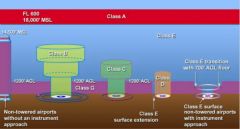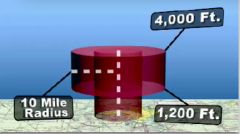![]()
![]()
![]()
Use LEFT and RIGHT arrow keys to navigate between flashcards;
Use UP and DOWN arrow keys to flip the card;
H to show hint;
A reads text to speech;
17 Cards in this Set
- Front
- Back
|
Class A airspace altitude?
|
18,000 - 60,000 AGL.
|
|
|
Class G airspace altitude?
|
Ground surface to base of Class E airspace. Often 700 to 1200 AGL.
|
|
|
What does a magenta dashed line represent?
|
Class E airspace from surface to altitude defined.
|
|
|
What does the inside of the magenta vignette represent?
|
Class G airspace from ground to 700 AGL.
Class E airspace above 700 AGL. |
|
|
What does the inside of the blue vignette represent?
|
Class G airspace from ground to 1200 AGL.
|
|

Airpace
|
Airspace
|
|
|
Characteristics of Class D airspace.
|
Smallest towered airspace.
Two way communication. Can enter if acknowledged by call sign. |
|
|
Which airspace is represented by a dashed blue line?
|
Class D
|
|
|
Normal size of Class D airspace?
|
5 mile radius.
|
|
|
Elevation of Class D airspace?
|
Ground to 2500 AGL.
|
|
|
Characteristics of Class C airspace.
|
Towered airport.
Radar service. Two way communication. Transponder with mode C. Can enter if acknowledged by call sign. |
|
|
Boundaries of Class C airspace.
|

5 mile core radius extending up to 4000 AGL.
10 mile shelf area radius extending up to 4000 AGL but no lower than 1200 AGL. |
|
|
When is communication recommended for Class C airspace?
|
Within 20 mile radius.
|
|
|
Characteristics of Class B airspace?
|
Two way communication.
Transponder mode C. Must be cleared for entry. At least a private pilot certificate and logged ground and flight instructions to land at that airport. |
|
|
Which airspace is depicted by a solid blue line?
|
Class B.
|
|
|
Size of veil around Class B airspace where Transponder with mode C is required?
|
30 miles
|
|
|
Characteristics of Class A airspace?
|
18,000 AGL to 60,000 AGL.
IFR instrumentation. Transponder mode C. |

